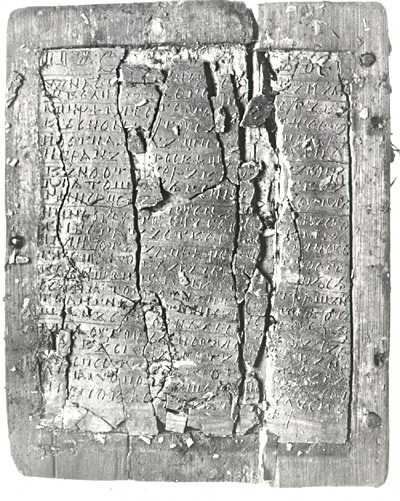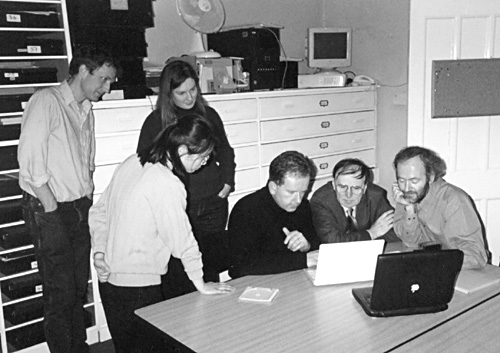
The 11th-Century Novgorod "Codex" on Waxed Wooden TabletsOn 13 July 2000 archaeologists in Novgorod, working under the direction of V. L. Ianin, unearthed a triptych of waxed limewood tablets with the incised texts still largely intact. This "codex" can be dated to the first quarter of the 11th century. It is the only early medieval object of its type from the entire Slavonic world, and one of very few from Europe as a whole. The text was written in the Cyrillic alphabet. The language was Church Slavonic, but the presence of specifically East Slav (early Russian) "mistakes" indicates that the scribe was an East Slav. The handwriting is the same throughout. The text preserved in the wax is from the Psalter (Psalms 75 and 76 in the Septuagint numeration). Apart from a few damaged letters it can be read easily and reliably.  Waxed limewood tablet from Novgorod However, when the wax was removed for conservation, it was revealed that, apart from the main text, the codex preserves - in the wood under the wax - faint traces of earlier lettering. These "hidden" texts are comprised of psalms and an assortment of religious works. Taken together they are many times longer than the main text in the wax. The "hidden" texts are of exceptional interest both for their literary content and for their historical implications. They include, for example, a series of hitherto unknown Slavonic compositions, apparently of native origin (i.e., not derived from Byzantine Greek), written by a single author and - as is clear from their contents - reflecting a non-canonical brand of Orthodoxy (which may explain why they have not been preserved in any other form). The study of the "hidden" texts poses exceptionally complex challenges, both technically and philologically. The texts have been examined in fours states: (i) in the original, in situ on the tablets; (ii) from photographs; (iii) on computer, from scans of photographic negatives, and (iv) on computer, from scans of the original wooden tablets (after conservation). The first mode of study was possible only for a brief period before the tablets were handed over for conservation work on the wood. Thus far the best information has been obtained from study in the third mode. The prime obstacle to the decipherment of the "hidden" texts is the fact that the traces of letters in the wood are barely discernible, so faint as to be almost indistinguishable from natural cracks, grain and other surface irregularities. A second and still greater difficulty arises from the fact that the wax was re-used many times, and each time the new text left a new layer of traces on the wood beneath. The Novgorod triptych codex is therefore a palimpsest. However, by contrast with "normal" palimpsests (which typically consist of two - or at any rate of very few - layers of superimposed text), the Novgorod codex consists of multiple layers. We can term it a "hyperpalimpsest". Trying to disentangle all the layers and decipher the texts on the Novgorod codex is therefore rather like trying to disentangle and decipher the layers of text on an old and much-used sheet of carbon paper. Nor can one separate the layers on the basis of handwriting (as one might in the case of a classical palimpsest) since the handwriting on all layers is identical. I am unaware of any precedents for the reading of such a "hyperpalimpsest". It has therefore not been possible to make use of existing techniques (there are none). Appropriate methods have had to be devised in the course of the work itself. Indeed, one cannot properly speak of "reading" any of these texts as one might speak of "reading" a text in a normal manuscript. With a normal manuscript we might first decipher the letters in sequence, and then grapple with their interpretation as text. In the case of the Novgorod tablets such a procedure would be wholly unrealistic. Any given line, or any given point in a line, consists of several layers of letters - or of the faint impression of possible letters - with no obvious indication of which is primary, of which goes in sequence with which to form words or phrases. Thus in order to find the sequence one must at each stage select the next letter or letters from a range of initially equal possibilities. This can only be done if one is constantly forming and testing hypotheses as to the possible shape and continuation of the emerging text. With a normal manuscript, reading mostly precedes interpretation; here it is an integral part of textual reconstruction at every stage, prior to any possible sequential reading. To give an example, from the fifth line of the first "page". At one point we can discern (among other possibilities) letters which might go together to form the word AZ" ('I'). We examine the area following this word, and find traces of a large number of different letters. Checking for possible groupings to go with AZ", we find that some of the letters might be combined as ESM", or ES"M" ("am"). Further checks show that ES"M" fits: all five letters can indeed be found where they "ought" to be if we follow the spacing of the earlier word. So, the hypothesis - that here we have words meaning "I am" is locally adequate. Whether it is in fact correct one can only tell from the continuation of the phrase. The longer a phrase which fits all the relevant phonetic, grammatical and stylistic criteria, the lower the chances that it is composed of purely accidental juxtapositions of letters originally belonging to quite separate notations. In the present example, after several stages of similar hypothesis and verification, we arrive at the sentence AZ" ES"M" ISTINA I ZAKON" I PROROTSI ("I am the Truth and the Law and the Prophets"), which fits all the relevant criteria. This reconstruction is further confirmed by the fact that the same phrase is apparently repeated several times.  The Novgorod and CSAD Teams examining a scanned image of the limewood tablets The reconstruction of the texts of the Novgorod codex is slow and labour-intensive. We have received valuable assistance from the Centre for the Study of Ancient Documents, during our visit to Oxford in February 2002. Although it was not possible on this occasion to bring the object itself to be re-scanned, our scans were processed so as to remove the effects of the grain and improve the visibility of incisions, and to an extent this made it easier to recognize and identify traces of lettering. It is to be hoped that further cooperation may lead to the development of improved techniques for dealing with hyperpalimpsests. Andrei Zalizniak (tr. Simon Franklin) Home | What's New | Events | Images | Links |
| Created on |